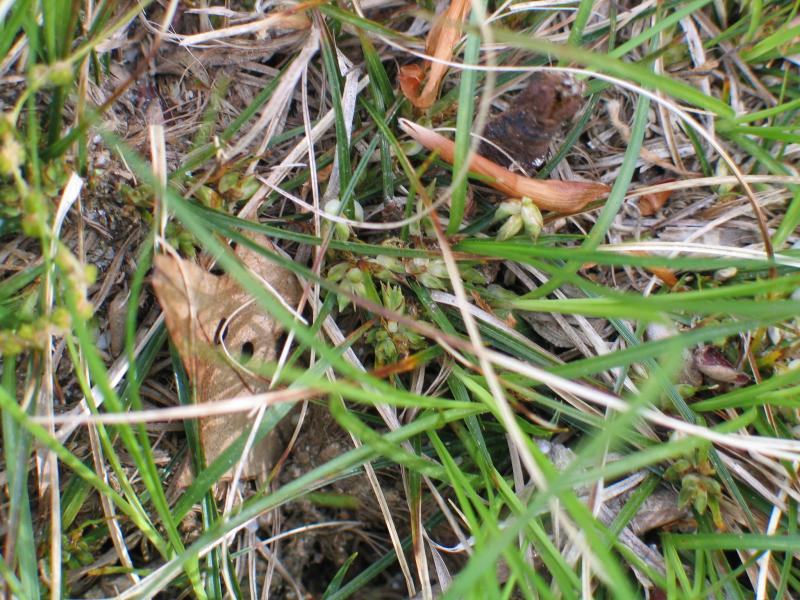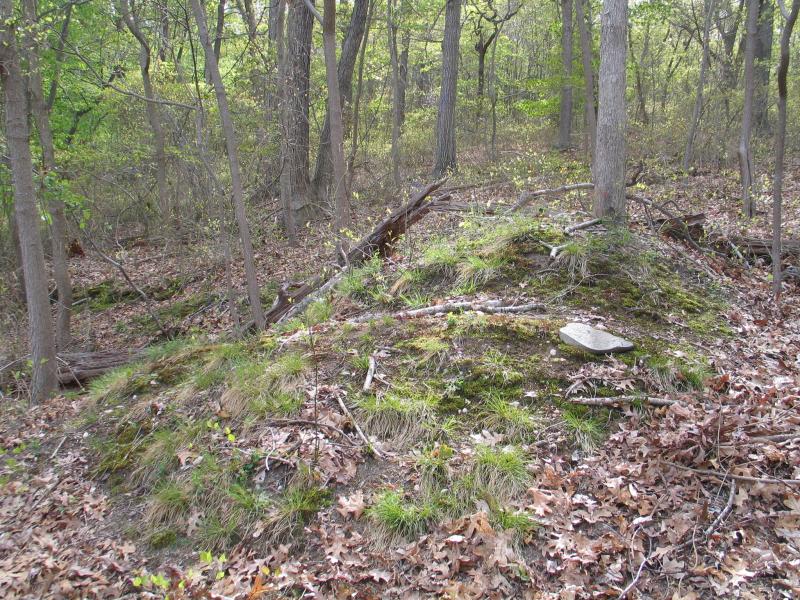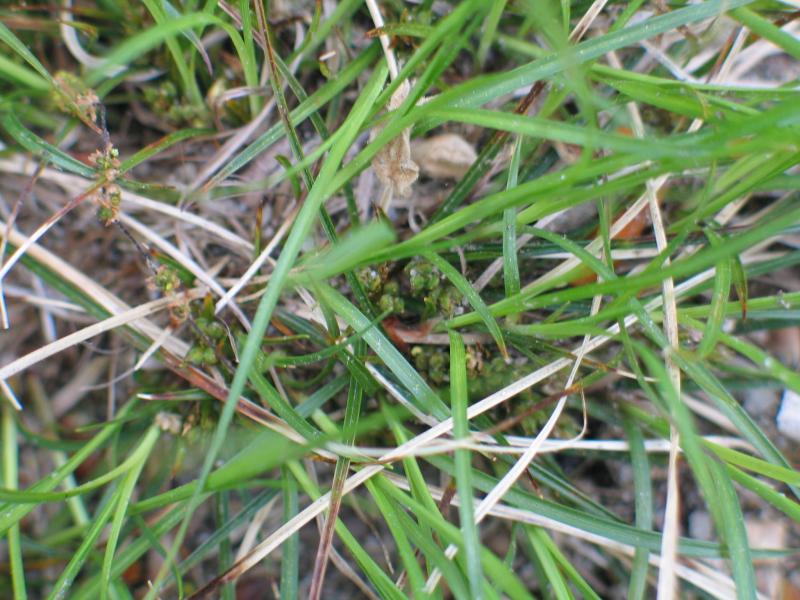Reznicek's Sedge
Carex reznicekii Werier
- Class
- Monocotyledoneae (Monocots)
- Family
- Cyperaceae (Sedge Family)
- State Protection
- Endangered
Listed as Endangered by New York State: in imminent danger of extirpation in New York. For animals, taking, importation, transportation, or possession is prohibited, except under license or permit. For plants, removal or damage without the consent of the landowner is prohibited.
- Federal Protection
- Not Listed
- State Conservation Status Rank
- S1S2
Critically Imperiled or Imperiled in New York - Especially or very vulnerable to disappearing from New York due to rarity or other factors; typically 20 or fewer populations or locations in New York, very few individuals, very restricted range, few remaining acres (or miles of stream), and/or steep declines. More information is needed to assign either S1 or S2.
- Global Conservation Status Rank
- G5
Secure globally - Common in the world; widespread and abundant (but may be rare in some parts of its range).
Summary
Did you know?
This sedge was quite recently discovered, and described as a species new to science, during fieldwork in New York's Hudson Highlands. It was first discovered by New York botanist David Werier in 2006. It is named for Dr. Anton Reznicek of the University of Michigan, a Carex expert and enthuiast, in recognition of his ongoing teaching and research on sedges.
State Ranking Justification
There are only four known extant and one historical population of Carex reznicekii from southeastern New York, including Long Island and the Lower Hudson Valley. This species is at the northerneastern edge of its range in New York with a few populations known from southern Connecticut and Rhode Island. It occurs in dry-mesic oak-hickory forests, which is a relatively common habitat. It also is difficult to identify after May, is a somewhat inconspicuous plant, and was only first described as a separate species in 2006. For these reasons, this species may be more common than current records indicate.
Short-term Trends
As it is a recently described species, we have no data on population trends for Carex reznicekii.
Long-term Trends
As it is a recently described species, we have no data on population trends for Carex reznicekii.
Conservation and Management
Threats
The ecology of this newly discovered species is not yet well-studied. As it occurs in forested habitats, canopy removal is a potential threat.
Conservation Strategies and Management Practices
Sites with Carex reznicekii should be managed to protect the forest canopy and prevent the dominance of exotics in the understory or herb layer.
Research Needs
Additional inventory work is needed to determine the distribution and extent of this newly-discovered, early-fruiting, and easily-overlooked sedge.
Habitat
Habitat
In New York Carex reznicekii grows in mesic to dry-mesic forests with rocky, shallow soils. It may prefer more calcareous, shaded, and lower-slope sites than Carex nigromarginata, though the two species' habitats overlap (New York Natural Heritage Program 2009, Werier 2006). Oaks are the dominant canopy trees at each of the four known New York sites (New York Natural Heritage Program 2009).
Associated Ecological Communities
- Appalachian oak-hickory forest
(guide)
A hardwood forest that occurs on well-drained sites, usually on ridgetops, upper slopes, or south- and west-facing slopes. The soils are usually loams or sandy loams. This is a broadly defined forest community with several regional and edaphic variants. The dominant trees include red oak, white oak, and/or black oak. Mixed with the oaks, usually at lower densities, are pignut, shagbark, and/or sweet pignut hickory.
- Appalachian oak-pine forest*
(guide)
A mixed forest that occurs on sandy soils, sandy ravines in pine barrens, or on slopes with rocky soils that are well-drained. The canopy is dominated by a mixture of oaks and pines.
- Coastal oak-heath forest
(guide)
A low diversity, large patch to matrix, hardwood forest that typically occurs on dry, well-drained, sandy soils of glacial outwash plains or moraines of the Atlantic Coastal Plain. The forest is usually codominated by two or more species of scarlet oak, white oak, and black oak.
- Coastal oak-holly forest*
(guide)
A semi-deciduous to mixed deciduous-evergreen broadleaf forest that occurs on somewhat moist and moderately well drained silt and sandy loams in low areas on morainal plateaus. In New York State this forest is best developed on the narrow peninsulas of eastern Long Island. The trees are usually not stunted, and are removed from the pruning effects of severe salt spray. The dominant canopy trees are black oak, black gum, red maple, and American beech. American holly is abundant in the subcanopy and tall shrub layers.
- Oak-tulip tree forest*
(guide)
A hardwood forest that occurs on moist, well-drained sites in southeastern New York. The dominant trees include a mixture of five or more of the following: red oak, tulip tree, American beech, black birch, red maple, scarlet oak, black oak, and white oak.
- Pitch pine-oak forest*
(guide)
A mixed forest that typically occurs on well-drained, sandy soils of glacial outwash plains or moraines; it also occurs on thin, rocky soils of ridgetops. The dominant trees are pitch pine mixed with one or more of the following oaks: scarlet oak, white oak, red oak, or black oak.
* probable association but not confirmed.
Associated Species
- Acer pensylvanicum (striped maple)
- Acer rubrum
- Acer saccharum (sugar maple)
- Allium tricoccum
- Amelanchier sp.
- Berberis sp
- Carex x
- Carex albicans var. albicans
- Carex communis
- Carex digitalis
- Carex lucorum (long-beaked carpet sedge)
- Carex nigromarginata (black-edged sedge)
- Carex pensylvanica (Pennsylvania sedge)
- Carex swanii (Swan's sedge)
- Carex tonsa var. rugosperma
- Carya alba
- Carya glabra (pignut hickory)
- Chimaphila maculata (spotted-wintergreen)
- Cornus florida (flowering dogwood)
- Danthonia spicata (poverty grass)
- Dennstaedtia punctilobula (hay-scented fern)
- Deschampsia flexuosa
- Dicanthelium boscii
- Dicanthelium dichotomum
- Dichanthelium dichotomum
- Dryopteris marginalis (marginal wood fern)
- Eurybia divaricata (white wood-aster)
- Fraxinus americana (white ash)
- Galium circaezans (forest wild-licorice)
- Gaylussacia baccata (black huckleberry)
- Hieracium venosum (rattlesnake hawkweed)
- Ilex opaca
- Iris sp.
- Lonicera japonica (Japanese honeysuckle)
- Luzula multiflora ssp. multiflora (common wood rush)
- Lysimachia quadrifolia (whorled-loosestrife)
- Maianthemum canadense (Canada mayflower)
- Parthenocissus sp.
- Pinus strobus (white pine)
- Poa bulbosa
- Polygonatum biflorum
- Polystichum acrostichoides (Christmas fern)
- Potentilla canadensis (dwarf cinquefoil)
- Prenanthes sp.
- Prunus serotina
- Quercus alba (white oak)
- Quercus coccinea (scarlet oak)
- Quercus montana (chestnut oak)
- Quercus rubra (northern red oak)
- Quercus velutina (black oak)
- Rhododendron periclymenoides (pinxter-flower)
- Rubus phoenicolasius (wineberry)
- Sassafras albidum (sassafras)
- Smilax rotundifolia (common greenbrier)
- Solidago rugosa
- Thalictrum thalictroides (rue-anemone)
- Thelypteris noveboracensis (New York fern)
- Toxicodendron radicans
- Tsuga canadensis (eastern hemlock)
- Vaccinium pallidum (hillside blueberry)
- Viburnum acerifolium (maple-leaved viburnum)
- Vitis sp.
Range
New York State Distribution
Carex reznicekii is currently known from Long Island and from Orange and Ulster Counties in the Hudson River Valley. There is also a single historical record from Manhattan. With abundant good habitat in the state, additional survey work is needed to determine this species' range in New York, particularly elsewhere in the Hudson Valley
Global Distribution
Carex reznicekii occurs from southern New England and New York south as far as Georgia, and west as far as southern Missouri and northern Arkansas (Werier 2006).
Identification Comments
General Description
Carex reznicekii is a densely tufted, evergreen, grass-like perennial. Its widest leaves are 1.2 to 2.2 (up to 2.4) mm wide. Its fruiting stalks (culms) are short, and often hidden by overlaying leaves near the base of the plant. The terminal spike is staminate, and the flowers and fruits occur in tight clusters (spikes) at the top of these culms. Although often hidden near the base of the plant, upon close inspection the spikes are not truly basal but rather arise singly from the nodes of the culms. The perigynia (fruit) are 2.5 to 3.9 mm long and 3-sided, with two prominent nerves extending their full length, the distal (away from the stem) end narrowed into a distinct beak.
Best Life Stage for Proper Identification
Mature fruits are preferred for positive identification of this species.
Similar Species
The two species most likely to be confused with Carex reznicekii are C. nigromarginata and C. umbellata. C. reznicekii differs from C. nigromarginata by having narrower leaf blades (generally 1.2 to 2.2 millimeters wide, as compared to 2.3 to 4.5mm wide for C. nigromarginata) and less reddish to purplish black color on the pistillate scales (which usually extends from the margin nearly to the mid-vein on C. nigromarginata.) It differs from C. umbellata by its lack of basal spikes, staminate spikes which have 2 to 4 pistillate spikes (versus 0 to 2 for C. umbellata), and staminate spikes extending no more than 3.7 millimeters past the pistillate spikes (versus staminate spikes extending up to 9.0 millimeters past the pistillate ones (if present) for C. umbellata).
Carex albicans and C. novae-angliae each have narrow leaves like those of C. reznicekii. C. albicans is rhizomatous rather than clump-forming, and has longer fruiting stalks. C. novae-angliae tends to fruit later (in June and July) than C. reznicekii, and has shorter (2.2 to 2.6 millimeters), nerveless perigynia.
Best Time to See
The fruits are visible from late April through May.
- Fruiting
The time of year you would expect to find Reznicek's Sedge fruiting in New York.
Reznicek's Sedge Images
Taxonomy
Reznicek's Sedge
Carex reznicekii Werier
- Kingdom Plantae
- Phylum Anthophyta
- Class Monocotyledoneae
(Monocots)
- Order Cyperales
- Family Cyperaceae (Sedge Family)
- Order Cyperales
- Class Monocotyledoneae
(Monocots)
- Phylum Anthophyta
Additional Resources
Best Identification Reference
Werier, David A. 2006. Carex reznicekii, a new widespread species of Carex Section Acrocystis (Cyperaceae) from eastern North America. SIDA 22(2): 1049-1070.
Other References
Crins, W.J. and J.H. Rettig. 2002. Carex Linnaeus sect. Acrocystis Dumortier. Pages 532-545 in Flora of North America Editorial Committee (editors), Flora of North America, north of Mexico, Volume 23, Magnoliophyta: Commelinidae (in part): Cyperaceae. Oxford University Press, New York, New York, USA. 608pp + xxiv.
Gleason, Henry A. and A. Cronquist. 1991. Manual of Vascular Plants of Northeastern United States and Adjacent Canada. The New York Botanical Garden, Bronx, New York. 910 pp.
Holmgren, Noel. 1998. The Illustrated Companion to Gleason and Cronquist's Manual. Illustrations of the Vascular Plants of Northeastern United States and Adjacent Canada. The New York Botanical Garden, Bronx, New York.
New York Natural Heritage Program. 2010. Biotics database. New York Natural Heritage Program. New York State Department of Environmental Conservation. Albany, NY.
New York Natural Heritage Program. 2024. New York Natural Heritage Program Databases. Albany, NY.
Reschke, Carol. 1990. Ecological communities of New York State. New York Natural Heritage Program, New York State Department of Environmental Conservation. Latham, NY. 96 pp. plus xi.
Weldy, T. and D. Werier. 2010. New York flora atlas. [S.M. Landry, K.N. Campbell, and L.D. Mabe (original application development), Florida Center for Community Design and Research http://www.fccdr.usf.edu/. University of South Florida http://www.usf.edu/]. New York Flora Association http://newyork.plantatlas.usf.edu/, Albany, New York
Weldy, Troy W. and David Werier. 2009. New York Flora Atlas. [S.M. Landry and K.N. Campbell (original application development), Florida Center for Community Design and Research. University of South Florida]. New York Flora Association, Albany, NY. Available on the web at (http://www.newyork.plantatlas.usf.edu/).
Links
About This Guide
Information for this guide was last updated on: March 7, 2019
Please cite this page as:
New York Natural Heritage Program. 2024.
Online Conservation Guide for
Carex reznicekii.
Available from: https://guides.nynhp.org/rezniceks-sedge/.
Accessed July 27, 2024.


